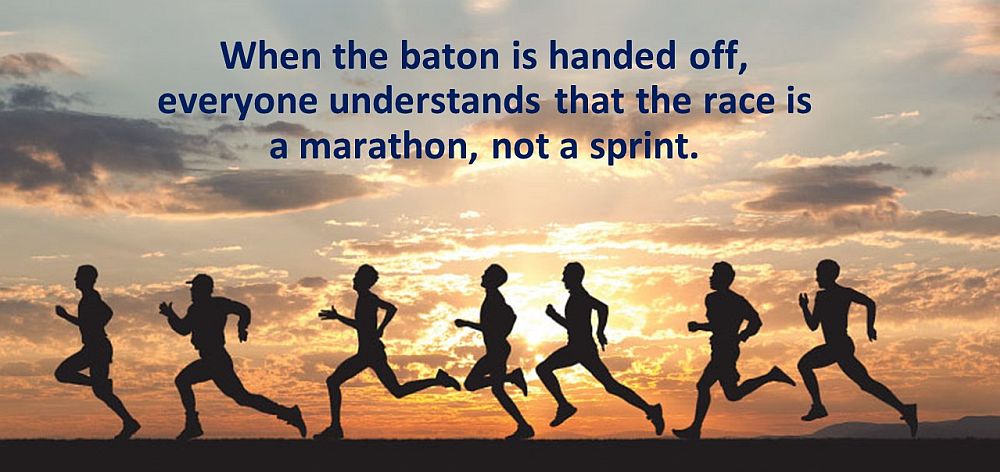WATERSHED CASE PROFILE SERIES: “The work of the DWWP is strategic. It is community based, and makes links interdepartmentally and with external agencies. And that in itself is the super power of what we do. It does not fit into a box of what a usual local government service is or does,” stated Julie Pisani, Program Coordinator for the Drinking Water & Watershed Protection Program in the Regional District of Nanaimo, Vancouver Island (released April 2021)
Note to Reader:
In April 2021, the Partnership for Water Sustainability in British Columbia released the 9th in the Watershed Case Profile Series. It features the Regional District of Nanaimo and its Drinking Water and Watershed Protection Program (DWWP). It is a narrative about commitment to partnerships, collaboration, awareness and education. These are building blocks in creating a water-resilient future.
The Watershed Case Profile Series is unique. The series showcases and celebrates successes and long-term ‘good work’ in the local government setting in British Columbia. Our spotlight is on champions in communities which are breaking new ground and establishing replicable precedents.
Storylines touch lightly on technical matters, yet are grounded in a technical foundation. The objective in ‘telling a story’ is to engage, inform and educate multiple audiences – whether elected, administrative, technical or stewardship. Stories in the series are presented in a magazine style to make it easier to read, comprehend and absorb technical information. Stories are designed to connect dots.
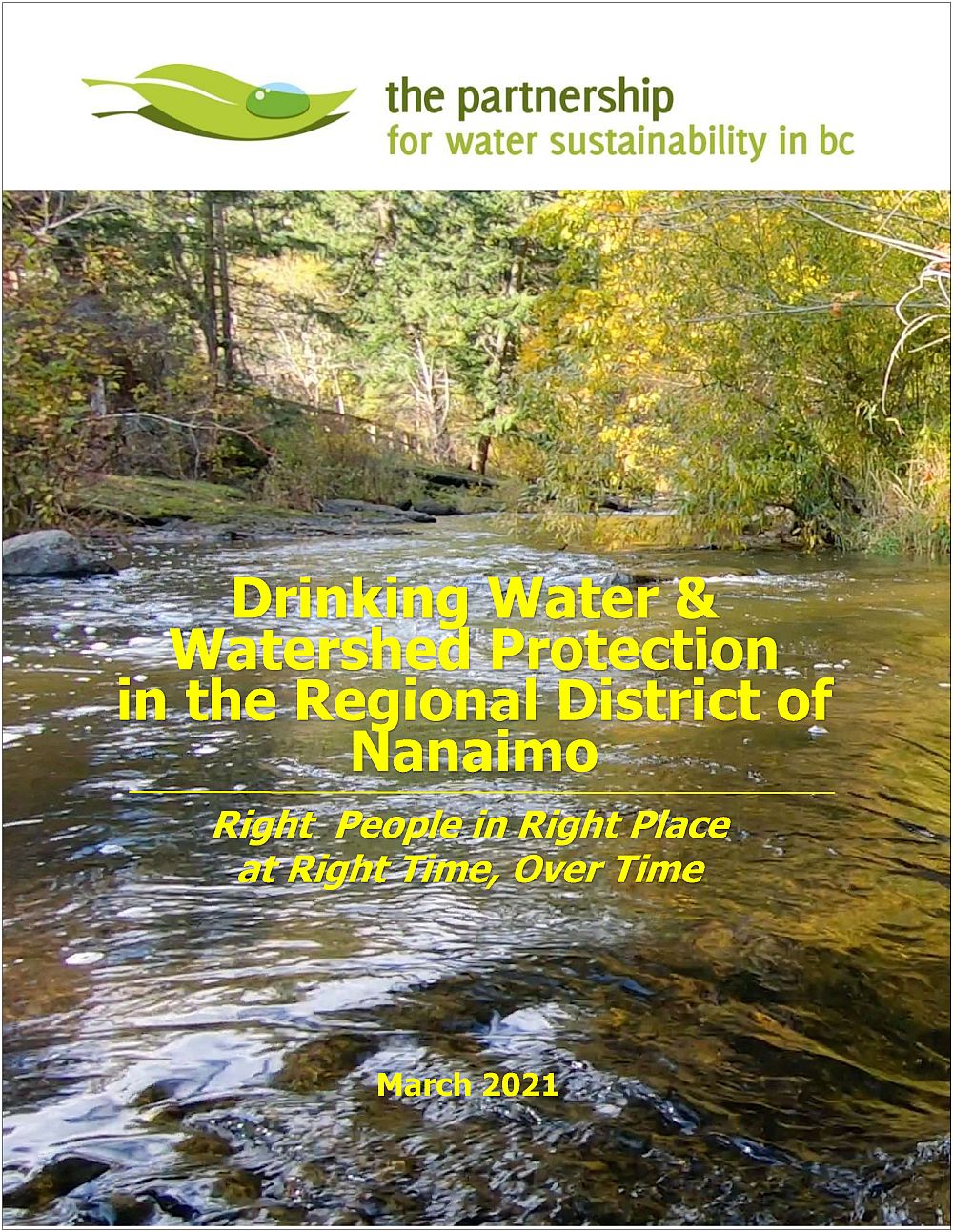
Nanaimo Region’s Journey to a Water-Resilient Future
“British Columbia is at a tipping point. Can local governments successfully adapt to a changing climate and create greener communities by bridging the gaps between science, policy and standards of practice to reconnect hydrology and stream ecology? Will they?” stated Kim Stephens, Executive Director, Partnership for Water Sustainability in British Columbia.
 “Through its Drinking Water and Watershed Protection program (DWWP), the Regional District of Nanaimo (RDN) is pointing the way forward and answering yes to both questions posed above. Leading by example is a journey. It takes time because a process must evolve as it unfolds. There is no shortcut.”
“Through its Drinking Water and Watershed Protection program (DWWP), the Regional District of Nanaimo (RDN) is pointing the way forward and answering yes to both questions posed above. Leading by example is a journey. It takes time because a process must evolve as it unfolds. There is no shortcut.”
“The phrase ‘cathedral thinking’ aptly describes the long-term commitment required by the community at large, successive Regional Boards, and generations of land and water professionals to achieve the design with nature sustainability vision that guides the program for drinking water and watershed protection.”

“We hope readers are inspired by what they learn from this Watershed Case Profile. We further hope there will be ripple effects because others embrace collaborative leadership and proceed down pathways that bridge the gaps between science, policy and standards of practice in their communities.”
“Simply put, the thread that weaves through the DWWP storyline is the right people in the right place at the right time, over time. It is not a sprint; it is a marathon. It is not one individual; it is a team effort. The DWWP is now implementing its second 10-year Action Plan.”
“The next ten years of DWWP will build on the foundational work in water outreach and data collection in the first decade. With longer datasets now available, trend analysis is possible, and interpretation of that data can more reliably be used for land and water management decisions.”
“The ‘story of the DWWP’ is not a report with conclusions and recommendations. Rather, we share the human side of the story of the DWWP journey as it has unfolded over the past two decades. It is an inspirational story. Download a copy, enjoy it, and be inspired!”
To Learn More:
DOWNLOAD A COPY: https://waterbucket.ca/rm/wp-content/uploads/sites/5/2021/03/Nanaimo-Region_Story-of-DWWP-Program_March-2021.pdf
Visit the Rainwater Management community-of-interest to access other documents in the Watershed Case Profile Series.
Funding, People and Continuity
 “The objective and mission of the DWWP program has always been about connecting land and water management. But the RDN couldn’t just leap straight there. We first had to build partnerships, trust, datasets and knowledge. We had to test ideas, learn, earn credibility, and deepen relationships across jurisdictions,” states Julie Pisani, DWWP Program Coordinator.
“The objective and mission of the DWWP program has always been about connecting land and water management. But the RDN couldn’t just leap straight there. We first had to build partnerships, trust, datasets and knowledge. We had to test ideas, learn, earn credibility, and deepen relationships across jurisdictions,” states Julie Pisani, DWWP Program Coordinator.
“The RDN demonstrates commitment to watershed initiatives and water sustainability by delivering the DWWP Action Plan with a long-term reliable funding source through parcel tax. This allows us to effectively leverage support from partners, because we are in it for the long game and we are coming to the table with some resources to get started. Not fund the whole thing, but get it off the ground and generate collaboration.”
The 5Cs – communication, cooperation, coordination, and critical thinking and creativity – are also essential ingredients. The DWWP Service is the container to hold the 5Cs. What is the container? “It is funding, people and continuity,” says Julie Pisani.

Right People in Right Place at Right Time, Over Time
The DWWP Service is a shared legacy, past and present. In the Watershed Case Profile, the spotlight is on the human dimension. We tell the DWWP story through the eyes of individuals whose leadership, and willingness to push the boundaries of their imaginations, translated a bold vision into a ground-breaking and unique program that has attracted province-wide attention for many years.
Strong and enduring political leadership is a critical success factor. Over the past two decades, successive Regional Boards have handed the DWWP baton to their successors to carry on the mission.
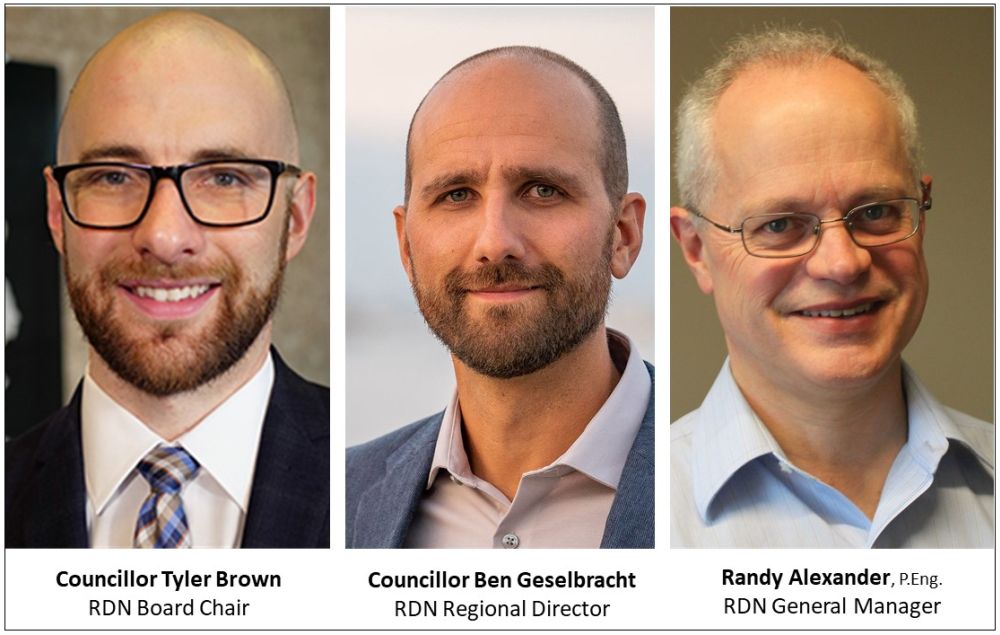
Driving Innovation
“The DWWP regional service was created explicitly to protect water at a watershed scale. The program is a leading example of how local governments can drive innovation and be a powerful influencer in watershed sustainability,” states Tyler Brown, RDN Board Chair and City of Nanaimo Councillor.
“We are proud of our accomplishments over the last 10 years, and our vision remains focused on the future. The DWWP program helps us make informed decisions today, and create the framework for sustainable decision making for the long term. Our recently adopted Action Plan for the next 10 years will allow the program to continue to innovate, better protect our water, and extend its reach.”
An Inter-Generational Lens
“Having stable funding has been a huge part of the success of the DWWP program. It has enabled education of both the community and those who hold political office. This laid the foundation for strong Board support,” adds City of Nanaimo Councillor Ben Geselbracht, one of three Regional Board members who guided DWWP Action Plan 2.0 over the finish line in 2020.
”When I think about sustaining the DWWP legacy from one Board to the next, it is about viewing it within a larger vision for creating sustainable human settlement, Looking through an inter-generational lens, the term permaculture is what resonates with me. It has three guiding principles. The first is care of land. It is foundational because the other two build on it. The second principle is care of people, and the third is care of the process.”
Forward Looking
“It really is important for us to be focused on the future,” emphasizes Randy Alexander, General Manager, Regional and Community Utilities. “We have mapped out the next 10 years with DWWP Action Plan 2.0, but our vision really needs to remain focused on a much longer time horizon. 10 years is not enough. 100 years is what we need to be looking at.”
Board leadership is important. “The continuing success of the RDN’s DWWP program comes down to the strong leadership of our elected officials, and our focus on forging and maintaining strong long-term partnerships, internally and externally.”

Let’s Just Be the Engine
“The DWWP Action Plan 2.0 was a massive, massive undertaking and we did it all with internal resources. We believed that if we did it ourselves, we would be the experts. The ideas resulted from a collaborative process that included community and stakeholder input and involved interdepartmental committees,” Murray Walters proudly states. He is the Manager of Water Services.
“The DWWP Action Plan 2.0 was developed by people who were around for the first ten years, or part of it, and are going to be here for at least some of the years required to implement it. We have a really fine understanding of where we are going. Our work plan is very granular, as are our expectations. In the DWWP program, our position right now is enviable because we have a lot of internal knowledge.”
Fund It. Resource It. Support It.
“A key point is that the work of the DWWP is strategic. It is community based, and makes links interdepartmentally and with external agencies. And that in itself is the super power of what we do. It does not fit into a box of what a usual local government service is or does,” concludes Julie Pisani.
Advocating Up:
“The quantum leap was, not just looking at our region, but then looking at our region in the context of decisions beyond those which are made at the Regional Board level. We began to funnel information up to senior government because we had built up a level of credence, both at the local and senior levels, to advocate for our region by providing sound local data to provincial decision-makers in a broader context.”
“Regional districts are in a unique position to coordinate and bring groups together – whether it is the member municipalities within the region; or the external agencies. And internally too – interdepartmental coordination is an important piece that we cannot overlook when connecting decisions around land and water.”
“It comes back to the organization itself identifying that: Yes, this is something that we do and therefore we fund it, we resource it, we support it. It evolves over time, and we support that evolution.”



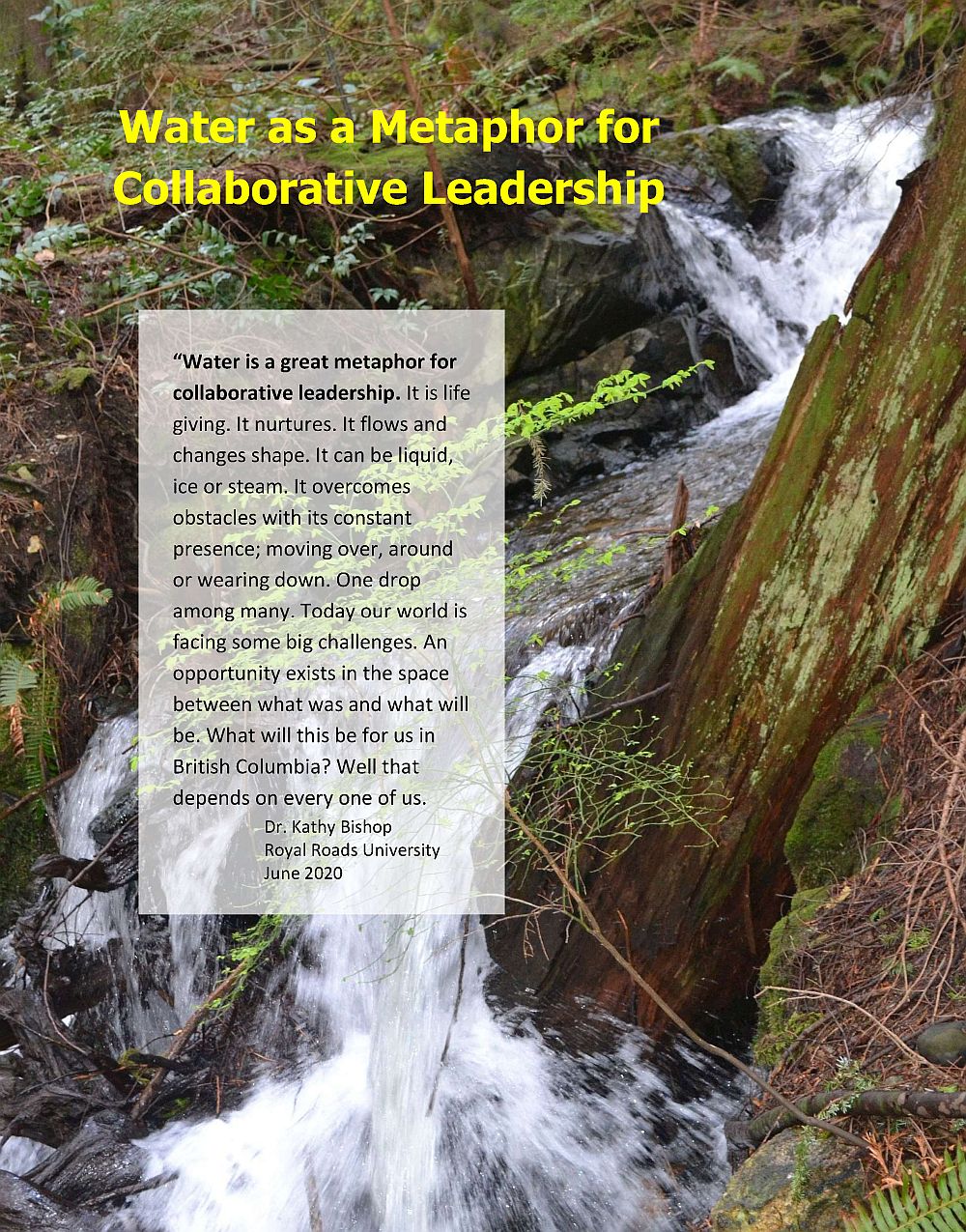
About the Partnership for Water Sustainability
Incorporation of the Partnership for Water Sustainability in British Columbia as a not-for-profit society on November 19, 2010 was a milestone moment. Incorporation signified a bold leap forward. Two decades earlier, a group of like-minded and passionate individuals, including representatives of three levels of government, came together as a technical committee. Over time, this “water roundtable” evolved into The Partnership.
The umbrella for Partnership initiatives and programs is the Water Sustainability Action Plan for British Columbia. In turn, the Action Plan is nested within Living Water Smart, British Columbia’s Water Plan. Released in 2008, Living Water Smart was the provincial government’s call to action, and to this day transcends governments.
The Partnership’s guiding philosophy is to help others be successful. When they are successful, we are successful. The Partnership is led by a team of mission-focused volunteers, elders and collaborators. These individuals bring experience, knowledge and wisdom to the Partnership roundtable. This enhances the effectiveness of the Partnership as “the hub for a convening for action network”. Although many on the Partnership leadership team have retired from their day jobs, the water-centric mission continues.
TO LEARN MORE, VISIT: https://waterbucket.ca/about-us/
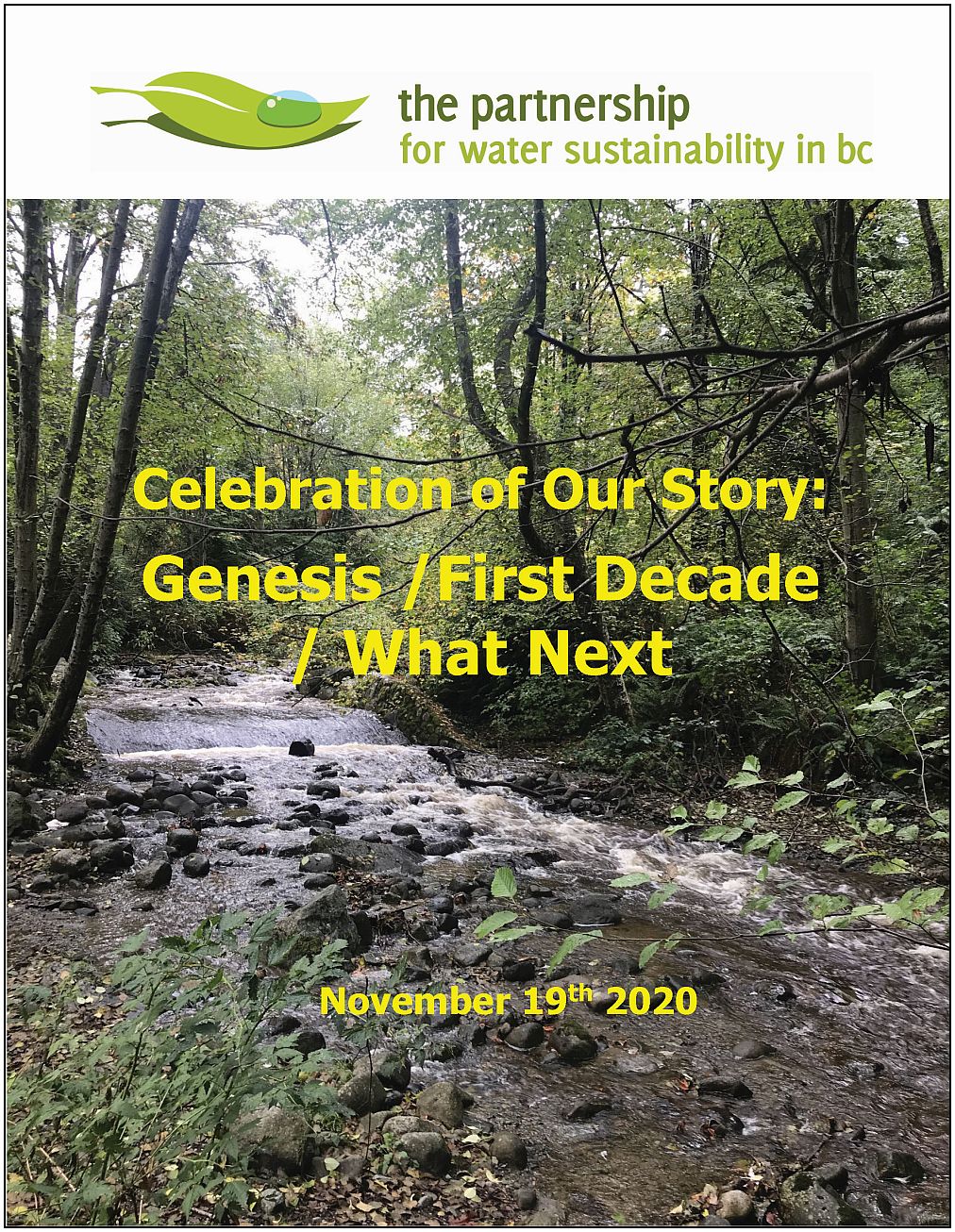
DOWNLOAD: https://waterbucket.ca/atp/wp-content/uploads/sites/9/2020/11/PWSBC_Story-of-First-Decade_Nov-2020.pdf


